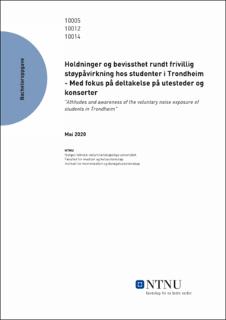| dc.contributor.advisor | Bjørnerås, Anita Blakstad | |
| dc.contributor.author | Kucharska, Maja Matylda | |
| dc.contributor.author | Rudi, Kristina | |
| dc.contributor.author | Johansson, Agnes Maria Trøhaugen | |
| dc.date.accessioned | 2020-06-20T16:00:32Z | |
| dc.date.available | 2020-06-20T16:00:32Z | |
| dc.date.issued | 2020 | |
| dc.identifier.uri | https://hdl.handle.net/11250/2658905 | |
| dc.description.abstract | Bakgrunn: Verdens helseorganisasjon rapporterte at 1,1 milliard unge voksne risikerer hørselstap på grunn av høye støy- og lydnivåer på utesteder og konserter. Studenter er gruppen som oftest utsetter seg for frivillig støyeksponering gjennom hyppig deltakelse på utesteder og konserter, med veldig høye støy- og lydnivåer. Tidligere forskning viser også at studenter er dårlige til å bruke hørselspreventive tiltak, til tross for noe kunnskap om hørselsrelaterte konsekvenser fra høye støy- og lydnivåer. Manglende regelverk gir ingen garanti, for at besøkende av utesteder og konserter oppholdes i forsvarlige støy- og lydnivåer.
Formål: Studien har som formål å undersøke hvorledes studentene er bevisst sine holdninger angående frivillig støyeksponering, og bruk av preventive tiltak.
Metode: Studien er en kvantitativ studie med et survey. Målgruppen for studien er studenter i Trondheim, hvor deltakernes alder er 19-28 år.
Resultat: Undersøkelsen viser at hørselspreventive tiltak benyttes i mindre grad på utesteder (10,7% (n=56)), enn på konserter (21,4% (n=56)). 51,8% (n=56) rapporterer om at de glemmer å bruke hørselsvern og 39,3% (n=56) har ikke tenkt over dette. 33,9% (n=56) velger å ikke bruke hørselsvern grunnet vanskeligheter med å kommunisere. Halvparten er klar over at høye lydnivå kan føre til hørselstap og tinnitus, 1 av 4 er bekymret for å tilegne seg hørselstap eller tinnitus og 36,4% (n=56) opplever tinnitus etter en kveld på utested eller konsert. Til tross for mange studenter (44,6 % (n=56)) som opplever musikken på utesteder og konserter som ubehagelig høy, og 51,8% (n=56) som har valgt å forlate et utested eller en konsert grunnet høye lydnivå, blir hørselspreventive tiltak kun benyttet av >10% (n=56).
Konklusjon: På tross av at mange studenter opplever lydnivået på utesteder som ubehagelig høyt, er det mange som er bevisst konsekvensene av dette, men likevel velger å ikke benytte seg av hørselspreventive tiltak. Flere velger heller å forlate et utested eller en konsert, enn å bruke hørselsvern. Det virker å være negative holdninger til bruk av hørselsvern, og dette baseres på ulike årsaker; for eksempel manglende informasjon om lydnivå og utilgjengeligheten av hørselsvern. Det finnes heller ikke retningslinjer for å ivareta besøkende på utesteder, sammenlignet med konserter. Det kommer frem i vår undersøkelse at konserter er en arena som gir større rom for bruk av hørselspreventive tiltak. Studentene viser i noen grad bevissthet angående høye støy- og lydnivå, men holdninger til bevisst bruk av hørselsvern kommer ikke frem. | |
| dc.description.abstract | Background: The World Health Organization reported that 1.1 billion young adults are at risk of hearing loss due to, among other things, high noise and sound levels at nightclubs and concerts. Students are the group most often exposed to voluntary noise exposure by frequent participation in nightclubs and concerts with very high noise and sound levels. The previous research also shows that the students poorly use hearing protection despite some knowledge of the bad impact of high noise on the human hearing system. A lack of regulations in this field does not guarantee that visitors of nightclubs and concerts are safe with the level of clamour they are surrounded by.
Aims: The study investigates what attitudes and how much awareness there is among students in Trondheim regarding the topic. It is also desirable to examine what contributes to making the choices.
Methods: This research is a quantitative study with a questionnaire. The target group for the investigation are students in Trondheim aged between 19 and 28 years.
Results: The study results show hearing protection are used to a lesser extent at nightclubs (10,7% (n=56)) than at concerts (21,4% (n=56)). 51,8% (n = 56) report having forgotten to use hearing protection and 39.3% (n=56) have not thought about why they choose to not use it. 33,9% (n = 56) choose not to use hearing protection because of difficulties in communicating. Half of the students are aware that high noise levels can cause hearing loss and tinnitus. 36.4% (n = 56) experience tinnitus after a night out at a nightclub or concert, and 1 in 4 is concerned about hearing loss and tinnitus. Almost half of the students (44.6% (n=56)) experience the music in nightclubs and concerts as unpleasantly loud, and 51.8% (n = 56) have chosen to leave the nightclub or a concert because of high noise levels. Unfortunately, hearing protection is used by >10% (n=56).
Conclusion: Even though 4many of the students experience the noise level at night spots as uncomfortably loud, and know the auditory consequences of this, very few choose to use hearing protection. More people choose to leave a nightclub or a concert than to use hearing protection. There seems to be negative attitudes towards the use of hearing protection, and this is based on various reasons. Lack of sound level information and inaccessibility of hearing protection. There are also no guidelines for safeguarding visitors to nightclubs, compared to concerts. However, it turns out that concerts are an arena that provides greater scope for both use and availability of hearing protection. The students show some extent awareness and knowledge regarding high noise and sound levels and the impact of voluntary noise exposure on hearing, but attitudes around use of hearing protection do not emerge. | |
| dc.publisher | NTNU | |
| dc.title | Holdninger og bevissthet rundt frivillig støypåvirkning hos studenter i Trondheim
- Med fokus på deltakelse på utesteder og konserter | |
| dc.type | Bachelor thesis | |
